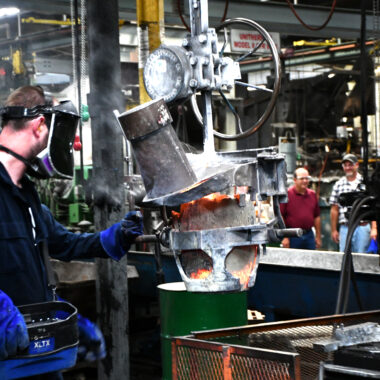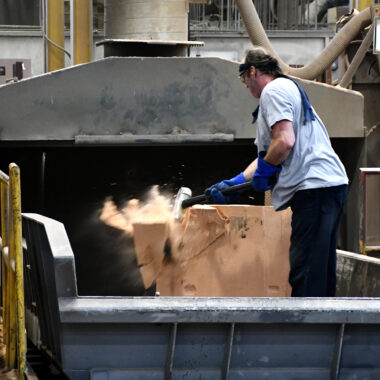Making The Most Of Effectiveness: Advanced Aluminum Casting Solutions Revealed
Making The Most Of Effectiveness: Advanced Aluminum Casting Solutions Revealed
Blog Article
Dive Into the World of Light Weight Aluminum Spreading: Comprehending the Various Methods
Aluminum spreading is a fundamental process in the manufacturing sector, with various approaches employed to produce intricate and exact parts. Comprehending the different methods used in light weight aluminum spreading can supply valuable understandings into the capacities and restrictions of each approach. From the standard sand casting technique to the advanced die casting process, each method provides one-of-a-kind benefits relying on the needs of the project. Checking out these diverse methods can use a comprehensive view of the possibilities within the world of light weight aluminum spreading and how each strategy contributes to shaping the contemporary manufacturing landscape.
Sand Spreading Method
Sand spreading, a widely-used approach in light weight aluminum casting procedures, includes creating mold and mildews made of compacted sand for putting molten steel. Once the mold and mildew is prepared, it is securely positioned in a flask and molten light weight aluminum is poured right into the cavity.
After the steel has actually cooled and solidified, the sand mold is damaged away to disclose the aluminum casting. Sand casting enables the manufacturing of complicated shapes and huge components that might be expensive or challenging to produce making use of various other approaches. It is also a lasting technique as the sand can be recycled and utilized several times, reducing waste in the casting process.
Long-term Mold Method

One significant benefit of the Long-term Mold Technique is the improved dimensional precision it uses. The metal mold permits tighter tolerances and finer details in the final light weight aluminum spreadings contrasted to sand spreading techniques. This accuracy makes it a favored selection for applications where tight dimensional control is important, such as in the aerospace and vehicle markets.

Pass Away Casting Refine

Financial Investment Casting Technique
Utilizing a precision spreading technique, Financial investment Casting Approach includes producing elaborate aluminum parts by pouring liquified metal into a ceramic mold and mildew. This official website process, additionally called lost-wax casting, starts with the creation of a wax pattern of the desired part. This wax pattern is after that coated with a ceramic material to develop a shell. As soon as the ceramic shell is set, it is warmed to eliminate the wax, leaving behind a hollow ceramic mold.
Investment casting is commonly made use of for making parts in markets where tight tolerances and detailed designs are needed, such as aerospace, auto, and clinical devices. The convenience and precision of the Investment Casting Method make it an important method in the world of light weight aluminum spreading.
Lost Foam Casting Approach
Having explored the elaborate precision of Financial blog investment Casting Method, the emphasis now changes to the innovative method of Lost Foam Spreading in aluminum component manufacturing. Lost Foam Spreading, also referred to as evaporative pattern casting, is a modern method where a foam pattern of the desired component is developed and after that covered with a refractory product. The covered foam pattern is after that buried in sand, and molten aluminum is put right into the mold. As the metal fills up the mold and mildew, the foam vaporizes due to the warm, leaving a visit the website clean cavity in the shape of the preferred part.
Additionally, Lost Foam Spreading is an economical procedure as it reduces the requirement for cores and allows for the manufacturing of lightweight elements. In spite of its advantages, Lost Foam Casting requires cautious control of the spreading process to ensure and prevent flaws high quality elements.
Verdict
To conclude, aluminum casting offers a variety of methods such as sand spreading, permanent mold method, pass away casting, investment casting, and lost foam spreading. Each approach has its own advantages and applications, making aluminum casting a flexible and extensively used process in numerous sectors. Recognizing the distinctions in between these approaches is essential in picking the most suitable casting technique for particular production needs.
Sand casting, a widely-used approach in light weight aluminum spreading procedures, involves creating mold and mildews made of compacted sand for putting liquified metal. aluminum casting.The Irreversible Mold And Mildew Strategy, like sand spreading, is an additional widespread approach utilized in aluminum spreading processes, using unique benefits in terms of mold reusability and dimensional accuracy. The steel mold and mildew allows for tighter tolerances and better details in the last aluminum spreadings contrasted to sand casting techniques. The 2 primary types of die casting are cold chamber pass away casting and warm chamber die casting, each ideal for different kinds of aluminum alloys.In conclusion, light weight aluminum casting offers a range of approaches such as sand spreading, permanent mold and mildew technique, pass away casting, investment spreading, and lost foam casting
Report this page